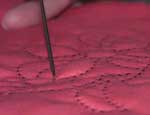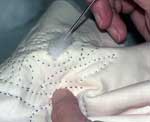
 |
 In
Italian trapunto means "to embroider," and in Latin it means "to prick with
a needle." English and American quilters usually call the technique stuffed
work.
In
Italian trapunto means "to embroider," and in Latin it means "to prick with
a needle." English and American quilters usually call the technique stuffed
work.
This style originated around the fourteenth century in Sicily. It became popular for clothing and other decorations in some parts of Europe, too, especially in Tudor England (A.D. 1485-1550) and in Marseilles, France, in the 1600s. Trapunto was brought to America by immigrants from these countries. A quilt made in this technique would have been considered elegant.
In trapunto, the quilter sews lines of stitches through the quilt sandwich (the quilt top, the batting, and the quilt backing) with a running stitch. It looks like this: - - - - - - - -. The stitching line outlines flowers, leaves, feathers, vases, or other motifs in the pattern. Sometimes extra batting or other stuffing material, like cotton, is placed inside a motif as it is outlined with stitches.
 Another
method of inserting batting is to stuff it through holes in the quilt backing
after the quilting lines are sewn in. The quilt is turned over. On the
back of each motif that is to be stuffed, the quilter uses a stiletto (like
a toothpick or darning needle) to separate the threads of the thin muslin
backing. With the stiletto the quilter pushes tiny pieces of stuffing through
the little hole. When the space is evenly stuffed, the quilter moves the
threads back into place. It takes a long time to make trapunto designs.
Another
method of inserting batting is to stuff it through holes in the quilt backing
after the quilting lines are sewn in. The quilt is turned over. On the
back of each motif that is to be stuffed, the quilter uses a stiletto (like
a toothpick or darning needle) to separate the threads of the thin muslin
backing. With the stiletto the quilter pushes tiny pieces of stuffing through
the little hole. When the space is evenly stuffed, the quilter moves the
threads back into place. It takes a long time to make trapunto designs.
The background quilting stitch for stuffed work is often a stipple. Stippling consists of randomly placed little stitches, close to each other, that create a dotted texture. Because there are many stitches close together, the stippled background lies flatter that the rest, making the stuffed parts stand out even more.
|
|
Copyright © 2000 Illinois State Museum Society